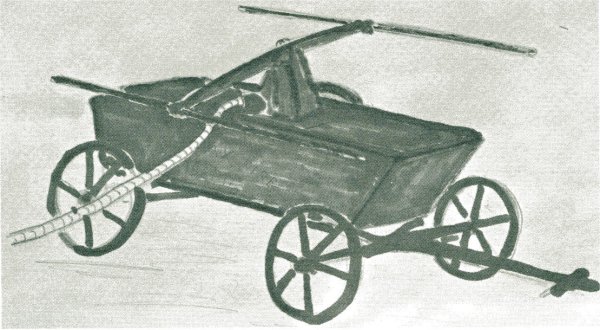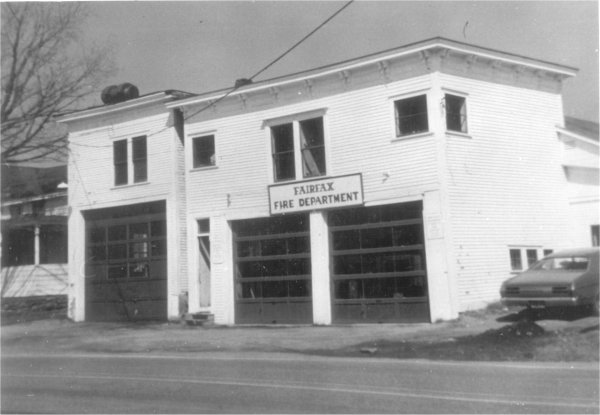|
Henry
|
 |
« : March 06, 2005, 07:08:12 PM » |
|
The History of the Fairfax Fire Department

By Retired Chief Larry Parsons
(The following History of the Fairfax Fire Department was recorded in 2002 by Retired Chief Larry Parsons. Larry had written this in July of 2002 for a display at the St. Albans museum for the Vermont State Firefighters Convention held in St. Albans that year. Larry passed away October 28, 2003. -- Larry wrote a number of stories about Fairfax and this story in its original form is located in the Fairfax Historical Society)
During the 1800s and early 1900s there was no active fire dept. Alerting was the ringing of the church bells and all able bodied men responded with their buckets being dressed in their own boots, raincoats, gloves and headgear.

There was a fire wagon as such being very small, hand pulled and hand pumped by six rugged men. It was stored in the back of the Town Hall, later to be the back room of the display room at Rich's funeral home. (This is actually the building presently occupied by The Fairfax Historical Society, before it was moved to the present site) This piece of equipment could not draft water so had to be fed by the bucket brigade. A 1 1/2" hose carried the water and according to Herb Bellows it would pump water to beat the band as long as the water and the strong backs held out. This rig got lost and is believed to be in a museum somewhere. (Albert Rich told me that this little pump was used at several fires that occurred at the old Blacksmith Shop located across from Mildred Warren's house. The old George & Nellie Rooney homestead which was a three story house was originally located across the road where the little ranch style house is now. Albert also told me that that little pump would pump water from Mill Brook up to the third floor of the Rooney house, provided the men pumping were rugged enough.)
Our next chapter comes into being when our neighboring town (Milton) ,bought a new 1937 International fire truck with all the equipment. They provided fire protection to us for many years; they tried hard and did well, but it was quite a distance away. In the 1940s a lightning storm hit the Rich home on Mill Street and burned the house of Ray Flanders next door. At Town meeting it was voted to buy fire equipment and a truck was bought down country and it broke down on the way here and was left where it died. (At the time of the BFA fire, when you read the reports of the fire, you will notice that Milton was the covering fire department for Fairfax)
The next chapter starts with the loan of a civil defense trailer mounted pump that had no water carrying capacity and little space for hose; it was a Chrysler engine and a 500 gallon Hale pump. A truck with the right sized hitch had to transport it to the fire.
The selectmen decided to buy new equipment and a truck was bought of C.P. Smith in Burlington and furnished by American Lafrance of Elmira N.Y. The new truck arrived in 1948 and was pressed into service. The pump was a two stage 500 G.P.M. with the Ford providing motivation. I believe that there were 9 calls that first year and it was soon discovered that the pump had to be dry in the cold weather.
Many chiefs were seen in the first year and the department did not jell until Joe Gokey took over. This truck proved to be a good working piece of equipment and was with us until 1973. It still resides on St. Albans hill with Dr. Payne and it still runs good. It had been sold to the town of Troy before it made it's way back here.

Since it's beginnings, there have been three fire stations. The original one was Malcolm Howard's garage that was part way between the Howard's Store and Gokey's Garage on Main Street. The firemen extended this little garage to more than double it's original size when it was decided to buy a second truck to take some of the load from the first truck. The second garage was the old Hicks furniture and funeral building that had recently been Charbonneau's body shop. This bigger building was needed when we bought the first tank truck which was also a first for a fire department. Many changes were made to the building including the removal and sale of the sliding doors. Overhead doors were bought from Maurice Ratte and installed. It was discovered that door openers were needed to get enough clearance. The old entrance was turned over to the ambulance crew. When we vacated, the town took over the old firehouse and used it for a town garage. A higher door was installed to make room for the grader. .(Mike Cain remembers his Dad working on the Town trucks in that bay. "Dad said if he was working in that bay, he knew there was a fire call because there would be an electronic snap just before the siren went off.") The Young family gave the department land for a new station and plans were laid for a new prefab metal building out at a space behind the present barn. It is now in service and has three double bays and a single for the ambulance, two offices and a nice kitchen and lunchroom; there are also two bathrooms and a shower plus a bunkroom for ambulance attendants to bunk out overnight.
Our first pumper now retired was replaced by a pumper built in Montpellier with a thousand G.P.M. pump and a thousand gallon tank and all the needed equipment and was bought with our first revenue sharing check which at the time was $28,000 dollars. This truck is still in service as pumper #1 and has been since equipped with a cascade system to fill air pack bottles. Engine 2 is a Hale International E1 built in Florida and equipped with everything needed. The truck is diesel and the transmission automatic the pump is a thousand G.P.M. Hale and the tank is rubber and is also a thousand gallon. The apparatus is all aluminum.
Engine three was a home built rig on a 41 army dodge radio truck too which we grafted a 500 G.P.M. pump on the front and drove it with a power take off and 4 vee belts that did not work well and were replaced by a chain drive. We replaced the Dodge with a Chevy that was LeClair's wrecker and after years of service it was replaced by a bigger Chevy chassis that was Don Pigeons. Recently the pump was done away with because of problems.
We originally had round helmets that were CD units that were replaced by Bullard fire helmets and after the Swanton fire were equipped with plastic shields for eye protection. Dick Leclair, who was chief at the time, changed to a new type that resembled the German helmets and that is what we have now.
A source of water was designed by Andrew King for the top of the hill on Stewart brook and the firemen all pitched in to see it built; it has been a good source but not seriously used.
We are now on our third round of tankers. Fairfax was one of the first to have a tank truck; it being a 1955 Ford that had trucked gasoline in a 1,000 gal tank. The truck looked good in the dark when we bought it. Later problems were a tank that leaked, an engine that hated to start hot, a hood that had a tendency to fly up and the loss of the rear wheels. All of these were over come eventually. We only had a small gate on the tank, there were no large ones at the time. The first call it made, we pumped water out of the top with a portable. This truck was sold to the horse track in North Fairfax. Albert and I went to Montpelier one afternoon to look into another tanker and the best we found was a Studebaker that was beyond our budget. On the way home, we saw several tankers over near the rail tracks and we inquired if they were available and how much money. A blue and orange GMC seemed to fit the bill and we bought it and it was sent to Middlesex to have a gate installed and the baffles to be altered with holes installed. I drove this jewel home from Montpellier and discovered that the front end lacked grease and being a V6 was not all that powerful. We used it for several years before taking the tank off and replacing the chassis with the 1973 town truck that Frank Cain drove. The old GMC went to Ferguson's farm in Fletcher and was equipped with a hay rack. The 73 was powerful and served us well, much of the tank swapping was done by Bonnett's welding and often at no cost to us. The Ford was replaced by another town truck that didn't have power steering but it served us well. One was a long wheeled tanker that I think Richard got somewhere and it was also an International, not a big engine but quite a powerful jewell. I don't know where it went, but it served well. With the new fire house we have room for three trucks and we have a tanker bought from Joyal fuels and two International trucks that were town snow plows, one has a square tank and the other a large stainless steel tank, this truck is on of the best running trucks, but can be a bear to handle because there are no baffles in the tank. We can roll close to 8,000 gal of water to a fire.
We have gone from a phone operated alerting system to a radio set up now. In the early days the phone central operator operated the sirens from her office and it worked well with two sirens, on the firehouse roof and a repeater on our store roof. A system of rings from meeting, in the village, out of the village, Westford or Fletcher and this system was used until the telephone office went on automatic. About the only place that had someone on duty all day and night was the funeral home and Mr. Rich took it in and handled it for many years. Our next system (Rich's sold it?) was a red phone system consisting of 9 red phones in different local homes that could also key the siren. This system was given up as too expensive.
The 9-1-1-call system works wel1 with the radio system.
Have a good night - Larry
|









